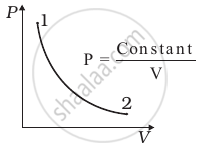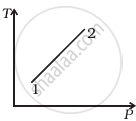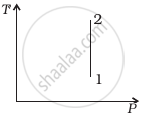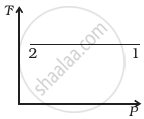Advertisements
Advertisements
Question
Write a note on free expansion.
Solution
- Free expansions are adiabatic expansions thus there is no exchange of heat between a system and its environment.
- Also, there is no work done on the system or by the system. Q = W = 0, and according to the first law of thermodynamics, ΔU = 0.
- For example, when a balloon is ruptured suddenly, or a tire is suddenly punctured, the air inside rushes out rapidly but there is no displacement of a piston or any other surface.
- A free expansion is different than other thermodynamic processes because it is an uncontrolled change. It is an instantaneous change and the system is not in thermodynamic equilibrium.
- A free expansion cannot be plotted on a p-V diagram. Only it's initial and the final state can be plotted.
APPEARS IN
RELATED QUESTIONS
Explain why The climate of a harbour town is more temperate than that of a town in a desert at the same latitude.
A thermodynamic system is taken from an original state to an intermediate state by the linear process shown in Figure

Its volume is then reduced to the original value from E to F by an isobaric process. Calculate the total work done by the gas from D to E to F
Answer in brief.
Why should a Carnot cycle have two isothermal two adiabatic processes?
Draw a p-V diagram showing positive work with varying pressure.
State the assumptions made for thermodynamic processes.
3 mole of a gas at temperature 400 K expands isothermally from an initial volume of 4 litres to a final volume of 8 litres. Find the work done by the gas. (R = 8.31 J mol-1 K-1)
Explain thermodynamics of the adiabatic process.
The V-T diagram of an ideal gas which goes through a reversible cycle A→B→C→D is shown below. (Processes D→A and B→C are adiabatic)

The corresponding PV diagram for the process is (all figures are schematic)
In an isochoric process, we have ____________.
Give the equation of state for an isothermal process.
Give an equation state for an isochoric process.
Draw the PV diagram for the isothermal process.
What is a cyclic process?
Can the given heat energy be completely converted to work in a cyclic process? If not, when can the heat can completely converted to work?
Explain in detail an adiabatic process.
Derive the work done in an adiabatic process.
In an adiabatic expansion of the air, the volume is increased by 4%, what is the percentage change in pressure? (For air γ = 1.4)
An ideal gas is taken in a cyclic process as shown in the figure. Calculate
- work done by the gas
- work done on the gas
- Net work done in the process

A monoatomic gas of pressure p having volume V expands isothermally to a volume 2V and then adiabatically to a volume 16V. The final pressure of the gas is ____________.
`("ratio of specific heats" = 5/3)`
An ideal gas is made to go from a state A to stale B in the given two different ways (see figure) (i) an isobaric and then an isochoric process and (ii) an isochoric and then an isobaric process. The work done by gas in the two processes are W1 and W2 respectively. Then,

Two identical samples of a gas are allowed to expand (i) isothermally (ii) adiabatically. Work done is ____________.
Assertion: Equal volumes of monatomic and polyatomic gases are adiabatically compressed separately to equal compression ratio `("P"_2/"P"_1)`. Then monatomic gas will have greater final volume.
Reason: Among ideal gases, molecules of a monatomic gas have the smallest number of degrees of freedom.
Ideal gas for which 'ϒ' = 1.5 is suddenly compressed to `1/4`th of its initial volume. The ratio of 4 the final pressure to the initial pressure is ______.
`(ϒ = "C"_"p"/"C"_"v")`
The work done on the system in changing the state of a gas adiabatically from equilibrium state A to equilibrium state B is 22.4 J. If the gas is taken from state A to B through another process in which the net heat absorbed by the system is 15.5 cal, then the net work done by the system in the latter case is ______.
( l cal = 4.2 J)
Which of the following processes is reversible?
Consider P-V diagram for an ideal gas shown in figure.

Out of the following diagrams (figure), which represents the T-P diagram?
 (i) |
 (ii) |
 (iii) |
 (iv) |
In a certain thermodynamical process, the pressure of a gas depends on its volume as kV3. The work done when the temperature changes from 100°C to 300°C will be ______ nR, where n denotes number of moles of a gas.
Explain the thermodynamic process.
Explain how can a gas be expanded at constant temperature.
In a cyclic process, if ΔU = internal energy, W = work done, Q = Heat supplied then ______.
